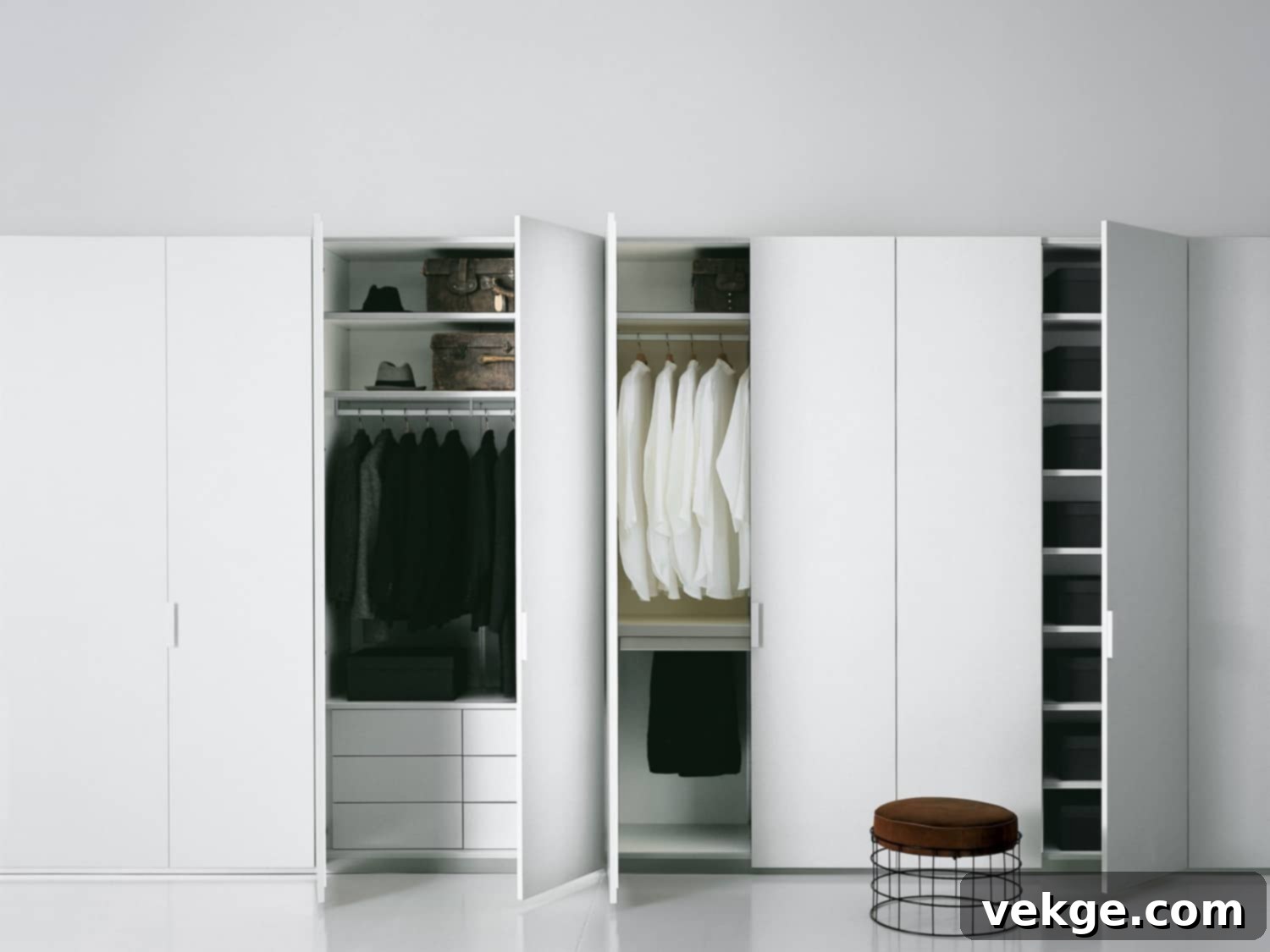Ultimate Guide to Choosing Wardrobe Doors: Enhance Your Home’s Style & Functionality
Wardrobes are more than just practical storage solutions; their doors serve as a prominent design element that can dramatically influence the overall aesthetics and functionality of any room. Given the significant investment of time and resources into furnishing our homes, selecting the right wardrobe doors is crucial for elevating your interior design.
This comprehensive guide delves into the various types of wardrobe doors available, explores essential design considerations, and examines popular material options. With this detailed information, you’ll be well-equipped to make informed decisions that align perfectly with your personal style, budget, and specific space requirements, transforming your wardrobe from a mere storage unit into a captivating focal point.
The Pivotal Role of Wardrobe Doors in Home Aesthetics and Functionality
The doors of your wardrobe offer a powerful opportunity to enhance your home’s interior. With an expansive array of styles, materials, and finishes, they can serve as a central design feature, dictating the mood and character of the space. A thoughtfully chosen wardrobe door can either seamlessly integrate with your existing décor, creating a harmonious and understated look, or boldly stand out, making a striking statement that captures attention.
Beyond their visual impact, wardrobe doors are fundamental to creating an organized, efficient, and highly functional living environment. The right doors ensure easy access to your belongings, optimize available space, and contribute to a clutter-free home, significantly improving its livability and daily convenience.
Exploring the Different Types of Wardrobe Doors
Understanding the various mechanisms and styles of wardrobe doors is the first step in making the best choice for your home. Each type offers distinct advantages and considerations regarding space utilization, accessibility, and aesthetic appeal.
Sliding Doors
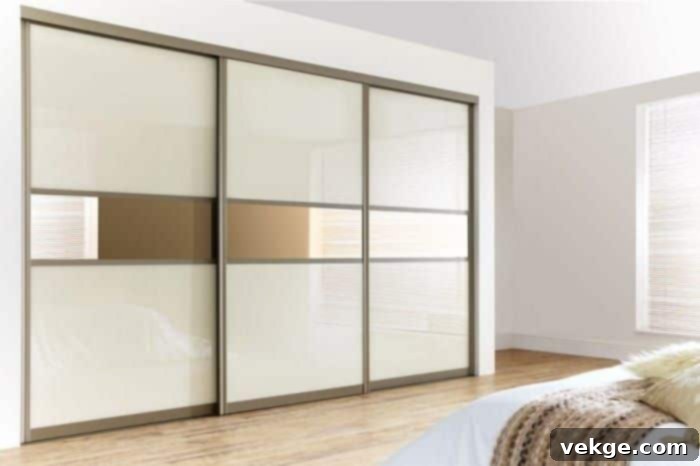
Sliding wardrobe doors are an exceptionally popular choice for modern homes, particularly where space is at a premium. These doors glide horizontally along a track, eliminating the need for swing-out clearance and making them ideal for narrow rooms, hallways, or smaller bedrooms. They offer a sleek, contemporary aesthetic and are available in a diverse range of materials and designs, including elegant glass, reflective mirrors, and classic wood finishes.
Advantages:
- Superior Space-Saving: Do not require any external clearance for opening, making them perfect for compact rooms.
- Effortless Operation: Designed for smooth and easy opening and closing with minimal effort.
- Modern Aesthetic: Provide a clean, contemporary, and uncluttered look to any interior.
- Versatile Material Options: Available in glass, mirror, various woods, laminates, and acrylics to match diverse décor styles.
Disadvantages:
- Limited Accessibility: Only one section of the wardrobe is accessible at a time, which can make it harder to view all contents simultaneously.
- Maintenance Requirements: Tracks and rollers need regular cleaning and occasional lubrication to ensure smooth operation and prevent sticking.
- Less Air Circulation: May not seal as tightly as hinged doors, but conversely, modern designs offer better seals, which can limit air circulation compared to fully open hinged doors.
Material Specifics and Installation Tips:
- Glass Sliding Doors: Create an illusion of openness and allow light to diffuse, enhancing brightness. Frosted or tinted glass options offer privacy while maintaining a sophisticated look.
- Mirrored Sliding Doors: Excellent for smaller rooms, as mirrors reflect light and visually expand the space, adding depth and a touch of glamour. They also provide a full-length dressing mirror.
- Wooden Sliding Doors: Offer warmth and timeless appeal. Available in various solid wood types, engineered wood like MDF, or chipboard with different veneers and finishes to suit traditional or contemporary styles.
- Installation and Maintenance Considerations: The quality of tracks and rollers is paramount for longevity and smooth performance. Opt for high-quality, sturdy hardware during installation. Different track systems (top-hung or bottom-rolling) influence the door’s stability and ease of movement. Regular vacuuming of tracks and occasional lubrication of rollers will keep your doors gliding effortlessly.
Hinged Doors
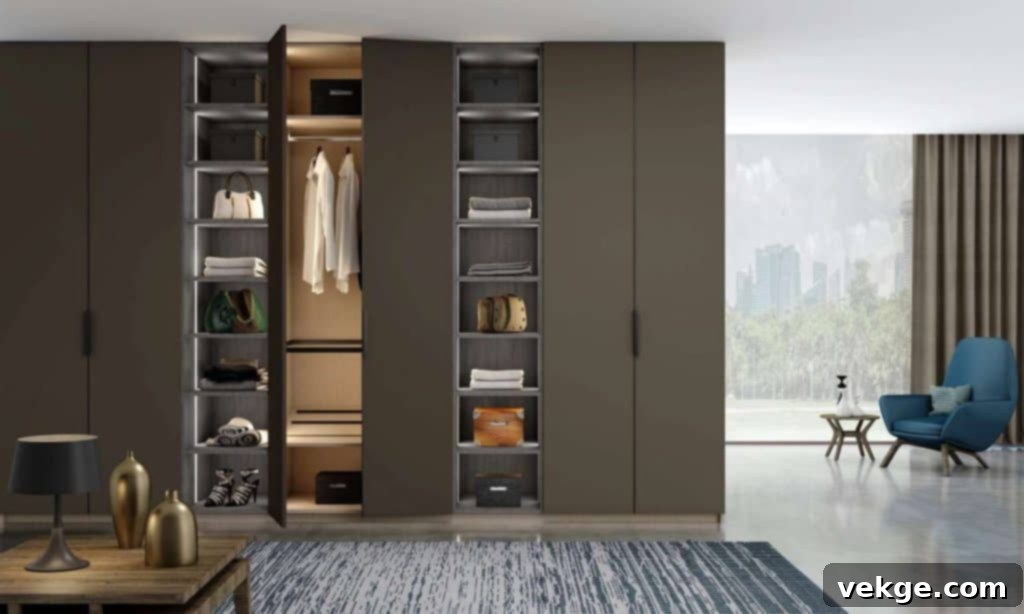
Hinged wardrobe doors represent the classic and most traditional choice, operating by swinging open and closed much like standard room doors. While they require adequate clearance space for full opening, they provide unrestricted access to your entire wardrobe interior, making organization and retrieval of items incredibly convenient. Hinged doors offer unparalleled design versatility, allowing for a vast array of configurations, hinge types, and material choices to perfectly match any personal preference or room aesthetic.
Pros:
- Full Accessibility: Offer complete, unobstructed access to the entire contents of your wardrobe, ideal for large, organized spaces.
- Extensive Design Options: Available in an almost endless variety of styles, finishes, and panel designs (e.g., shaker, flat panel, louvered).
- Customizable Hardware: A wide selection of hinges, handles, and knobs allows for personalized styling and functionality.
- Excellent Seal: Often create a tighter seal than sliding doors, offering better protection against dust.
Cons:
- Space Requirement: Demand significant clearance area for the doors to open fully, which can be impractical in smaller rooms or tight spaces.
- Potential for Wear: Hinges can wear down or become misaligned over time with frequent use, requiring occasional adjustment or replacement.
Design and Hardware Considerations:
- Variations in Design and Style: From rustic farmhouse to sleek contemporary, hinged doors can be customized to complement any interior. Options include simple flat panels for a minimalist look, raised or recessed panels for traditional elegance, or louvered doors for ventilation and a relaxed feel. They can be crafted from various materials like solid wood, MDF, glass inserts, or even upholstered panels.
- Selecting Hinges and Handles: Hinges are available in diverse materials, including durable stainless steel, classic brass, or modern matte black. You can choose between visible butt hinges that add a decorative touch or concealed European-style hinges for a seamless, sleek appearance. Handles and knobs offer another layer of personalization; select from traditional pull handles, contemporary bar pulls, or unique decorative knobs to complete your desired look. Push-to-open mechanisms are also an option for handle-less designs.
Bi-fold Doors
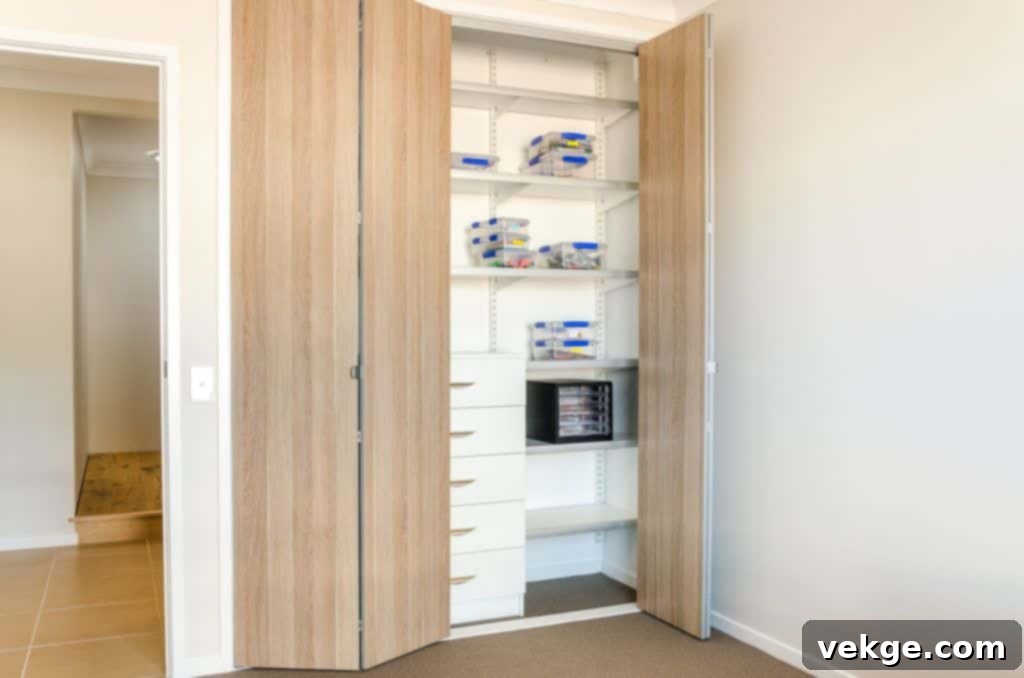
Bi-fold wardrobe doors offer an intelligent blend of space-saving and accessibility, making them an excellent choice for rooms where hinged doors might be too intrusive, but full access is still desired. These doors feature multiple panels that fold in half or concertina as they open, moving along a track. Common configurations include two-panel or four-panel designs, allowing for considerable flexibility in managing your wardrobe access within constrained environments.
Benefits:
- Space-Efficient Design: Require less swing-out space than traditional hinged doors, making them suitable for bedrooms or closets with limited room.
- Enhanced Access: Provide wider access to the wardrobe interior than sliding doors, allowing a broader view of contents.
- Aesthetic Versatility: Available in various materials and finishes to complement diverse interior styles.
Drawbacks:
- Hardware Maintenance: Like sliding doors, tracks and hinges require regular cleaning and maintenance to ensure smooth, quiet operation.
- Potential for Obstruction: While offering wider access, the folded panels can still partially obstruct the view of items immediately behind them.
- Width Limitations: May not be ideal for very wide openings, where a multi-panel sliding system might be more effective.
Configuration and Material Guidance:
- Choosing the Right Configuration: When selecting bi-fold doors, consider the available wall space and the typical contents of your wardrobe. Two-panel designs are generally best for smaller openings, while four-panel or even six-panel configurations are more appropriate for larger wardrobes, offering greater access. Always account for the slight clearance space needed for the doors to fold and stack neatly against the adjacent walls.
- Suitable Materials for Bi-fold Doors: Bi-fold doors can be crafted from a wide range of materials to match your desired aesthetic and durability needs. Popular options include solid wood for a robust, traditional look; engineered wood like MDF for painting or veneering; metal for an industrial edge; and glass inserts for light and modern appeal.
Key Design Considerations for Your Wardrobe Doors
Beyond functionality, the visual impact of your wardrobe doors is paramount. Thoughtful design choices ensure your wardrobe enhances, rather than detracts from, your room’s overall aesthetic.
Matching Your Overall Interior Design Style
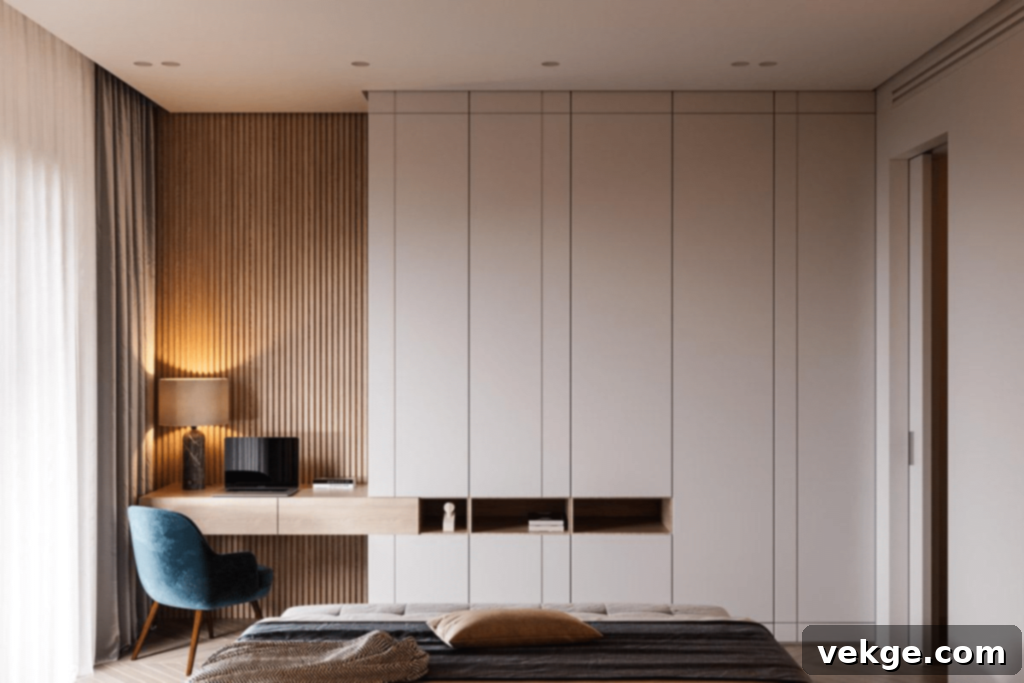
Your wardrobe doors should seamlessly integrate with your home’s existing décor and interior design theme. Consider the prevailing style you’re aiming for, whether it’s a sleek modern look, a cozy traditional ambiance, or a decluttered minimalist vibe. The color palette, textures, and finishes present in the room should guide your door selection.
- Modern and Contemporary: Characterized by clean lines, flat surfaces, and an absence of ornate details. Sliding doors with glossy finishes, handle-less designs, or integrated mirrored/glass panels perfectly encapsulate this look. Think neutral colors, geometric patterns, and metallic accents.
- Traditional and Classic: Often features intricate details, rich textures, and warm tones. Hinged doors with raised or recessed panels (like Shaker style), detailed moldings, or carved wood finishes are quintessential. Hardware in brass, bronze, or wrought iron complements this style beautifully.
- Minimalistic and Sleek: Focuses on simplicity, functionality, and uncluttered spaces. Mirrored doors, plain flat-panel doors in muted tones, or integrated handle designs contribute to a sense of spaciousness and serenity. The goal is to make the wardrobe visually disappear or blend effortlessly into the wall.
- Industrial or Rustic: Consider raw wood finishes, metal accents, or even barn-door style sliding mechanisms for an industrial loft or rustic farmhouse appeal.
Size and Space Constraints

Accurate measurements are non-negotiable for wardrobe doors to fit perfectly and function optimally. Before finalizing any design choice, thoroughly assess the available space, considering not just the width and height of the opening, but also the surrounding clearances.
- Taking Accurate Measurements: The “measure twice, cut once” adage is critical here. Use a reliable measuring tape, a spirit level to check for plumb and level surfaces, and a square for precise corner measurements. Account for potential variations in walls, floors, and ceilings. Professional measurement services are highly recommended for complex installations.
- Customization Options for Perfect Fit: Many suppliers offer custom-sized wardrobe doors, which are invaluable for non-standard openings or awkward alcoves. Customization ensures a seamless, built-in look that maximizes every inch of space and creates a cohesive aesthetic.
- Maximizing Storage Space with Appropriate Door Choices: The type of door directly impacts your internal storage. Sliding doors free up floor space externally but can limit internal access. Hinged doors offer full internal access, ideal for pull-out drawers, shelves, and hanging rails, but demand external swing space. Bi-fold doors strike a balance, offering good access without the full swing of hinged doors. Consider the depth of your wardrobe and how internal fittings will interact with your chosen door type.
Material Options for Your Wardrobe Doors
The material of your wardrobe doors plays a significant role in their appearance, durability, maintenance, and cost. Each material offers distinct advantages and contributes uniquely to the room’s atmosphere.
Glass
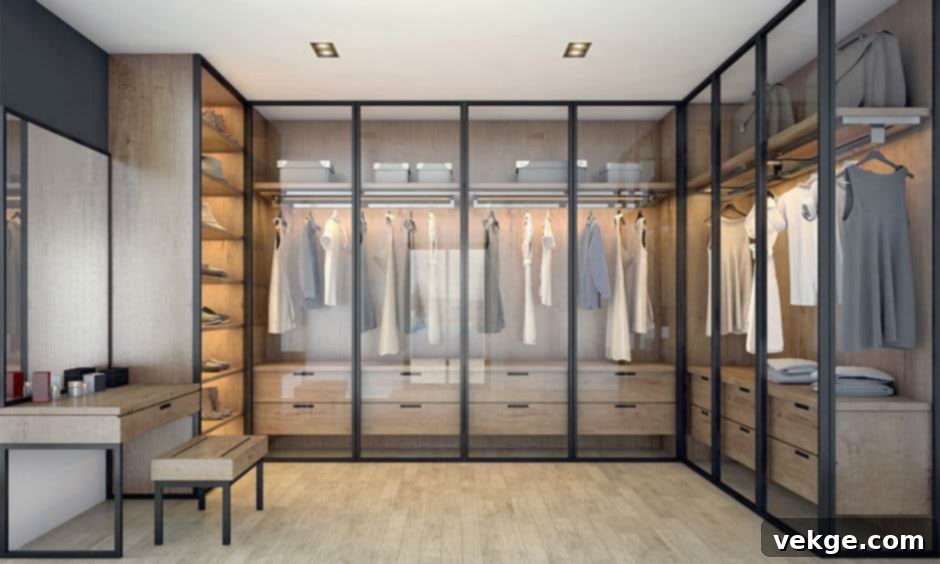
Glass wardrobe doors infuse a sense of sophistication and openness into any room. They excel at maximizing light flow, creating a brighter and more spacious feel. Available in various styles, from clear and frosted to opaque and back-painted, glass offers versatility for different aesthetic and privacy needs.
Pros:
- Elegant Designs: Offer a sleek, contemporary, and luxurious aesthetic.
- Light Enhancement: Increase natural light penetration, making rooms feel brighter and larger.
- Modern Appeal: Ideal for minimalist and contemporary interior design schemes.
- Color & Finish Variety: Can be frosted, etched, tinted, or back-painted in a wide range of colors.
Cons:
- Fragility: More susceptible to cracking or chipping than other materials, though modern safety glass greatly mitigates this.
- Maintenance: Prone to fingerprints, smudges, and streaks, requiring frequent cleaning to maintain their pristine appearance.
- Privacy Concerns: Clear glass offers no privacy, necessitating frosted or opaque options.
Types of Glass and Safety:
- Clear, Frosted, or Colored Glass: Choose clear glass for an unobstructed view and maximum light, frosted glass for diffused light and privacy, or colored/back-painted glass for a bold design statement.
- Shatterproof or Tempered Glass: For increased safety and durability, especially in households with children or pets, opt for tempered or laminated glass. These types are significantly stronger and, if broken, shatter into small, blunt pieces rather than sharp shards.
- Maintenance: Clean regularly with a soft cloth and a non-abrasive glass cleaner to prevent streaks and maintain clarity.
Mirror
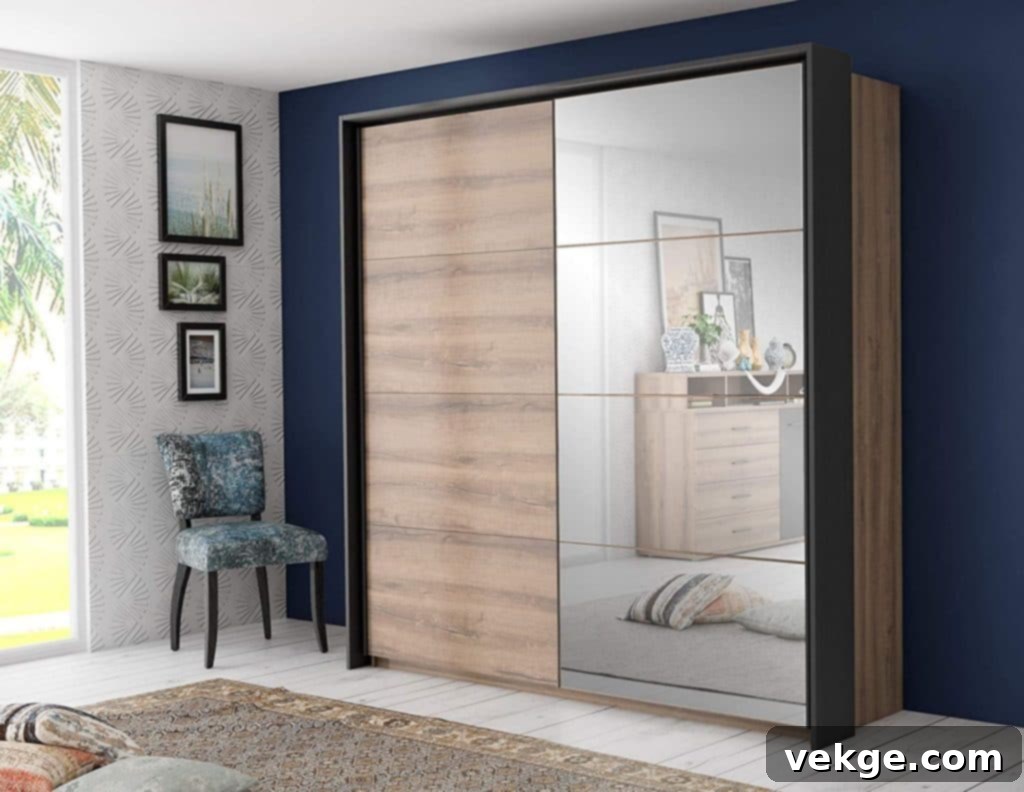
Mirrored wardrobe doors are a highly effective and stylish solution for enhancing both the perceived space and light within a room. They offer an elegant way to add sophistication, transforming a functional item into a striking design feature. Much like glass doors, mirrors excel at reflecting light, making any space feel brighter and more expansive.
Advantages:
- Visual Expansion: Create a powerful illusion of greater space, making small rooms appear considerably larger and more open.
- Increased Brightness: Reflect ambient and natural light, significantly brightening the room and reducing the need for artificial lighting.
- Integrated Functionality: Provide a full-length mirror, eliminating the need for a separate fixture and saving floor space.
- Luxurious Aesthetic: Add a touch of glamour and sophistication to any interior design.
Disadvantages:
- Weight: Mirrors are heavy, requiring robust framing and high-quality hardware for safe and reliable installation, particularly for sliding or bi-fold systems.
- Maintenance: Highly prone to fingerprints, smudges, and dust, demanding frequent cleaning to maintain their reflective clarity and shine.
- Cost: Generally more expensive than basic wooden or laminated doors due to the material and specialized installation requirements.
Utilizing Mirrors and Maintenance:
- Visual Expansion of Small Spaces: Mirrored wardrobes are a designer’s secret weapon for compact living areas. By reflecting the room, they effectively double its perceived size, adding depth and an open feel. They are also excellent for reflecting views or interesting architectural features.
- Cleaning and Maintaining Mirrored Wardrobe Doors: To keep mirrored doors sparkling, clean them regularly with a soft, lint-free cloth and a streak-free glass cleaner. Avoid abrasive cleaners or harsh scrubbing, which can damage the mirror’s surface or backing. For optimal shine, wipe immediately after spraying the cleaner.
Wood
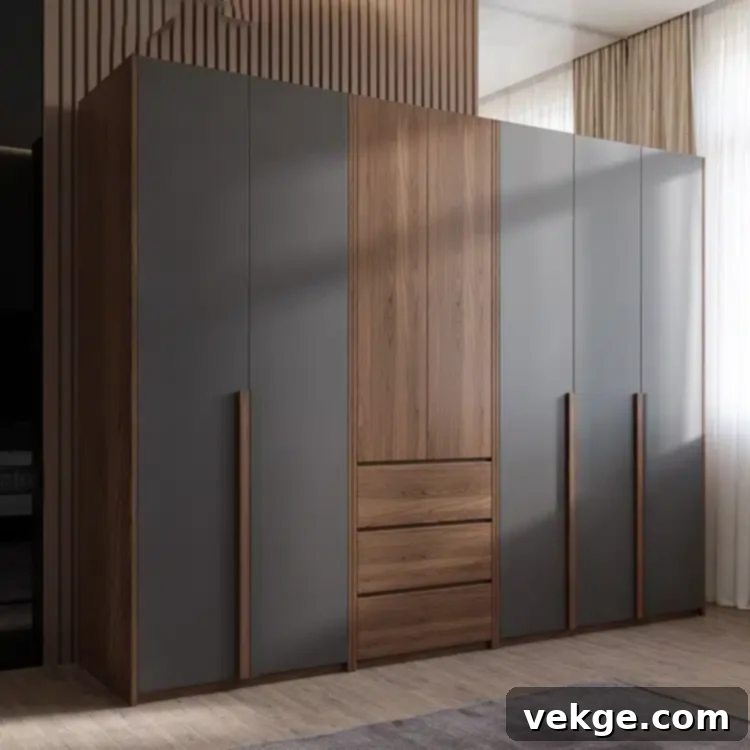
Wooden wardrobe doors offer a timeless appeal, bringing classic elegance and natural warmth to any room. Renowned for their robustness and durability, wood doors are a practical choice for busy households, capable of withstanding daily wear and tear while developing a beautiful patina over time. They are available in various types, from solid timber to engineered wood products with veneers.
Benefits:
- Durability and Sturdiness: Inherently strong and long-lasting, providing excellent resilience against impacts.
- Natural Warmth: Adds a rich, inviting, and sophisticated ambiance to the room.
- Versatile Aesthetics: Can be stained, painted, or carved to suit a wide range of traditional, rustic, or even contemporary styles.
- Variety of Options: Available in different wood species, veneers, and engineered wood products like MDF for various finishes.
Drawbacks:
- Susceptibility to Damage: Can be prone to scratches, chips, or dents, especially softer woods.
- Maintenance Requirements: Regular cleaning and occasional re-finishing may be required to maintain their quality and protect against moisture or sun damage.
- Environmental Factors: Wood can expand and contract with changes in humidity and temperature, potentially leading to warping if not properly treated or installed.
Types of Wood and Protective Finishes:
- Different Types of Wood: Options range from luxurious hardwoods like oak, maple, cherry, and mahogany, known for their distinct grains and durability, to more economical softwoods like pine. Engineered wood products such as MDF or plywood are excellent bases for painting or applying decorative veneers, offering stability and cost-effectiveness.
- Finishes and Coatings for Long-Lasting Durability: To protect wooden doors from moisture, fading, and daily wear, various finishes and coatings are essential. Varnish, lacquer, and polyurethane provide a durable, clear protective layer that enhances the wood’s natural beauty. Paint offers unlimited color customization and an additional layer of protection. Wax or oil finishes provide a more natural look and feel but may require more frequent reapplication. A high-quality coating is crucial to ensure the longevity and beauty of your wooden wardrobe doors.
Budgeting for Your Wardrobe Doors
Wardrobe doors, especially custom-designed or high-end options, can represent a significant investment in your home. Establishing a realistic budget from the outset is crucial for managing costs and making informed decisions. It’s important to remember that achieving a desirable look doesn’t always necessitate a hefty price tag; smart choices can deliver both quality and affordability.
- Setting a Realistic Budget: Begin by researching the approximate costs associated with different types of wardrobe doors, materials (e.g., solid wood, glass, mirror, laminate), and features you desire. Factor in not just the doors themselves, but also additional costs such as professional installation fees, hardware (hinges, handles, tracks), and delivery. Define your maximum spending limit and prioritize features to stay within it.
- Comparing Prices and Materials for Cost-Effectiveness: Once you have a clear idea of your preferred style and material, compare offerings from multiple manufacturers and suppliers. Look for sales, discounts, and package deals. Consider the long-term value: a slightly more expensive but durable material might save money on maintenance and replacement in the future. Always inquire about shipping fees, warranty terms, and return policies before making a final decision. Sometimes, opting for standard sizes over custom builds can significantly reduce costs.
- Balancing Quality and Affordability: The goal is to find a sweet spot where quality meets affordability. You don’t always need the most expensive option to achieve good results. For example, high-quality engineered wood with a beautiful veneer can offer the look of solid wood at a lower cost, especially when paired with durable hardware. Prioritize areas where durability is key (e.g., tracks for sliding doors) and consider more economical options for less stressed components.
Installation and Maintenance Tips for Wardrobe Doors
Proper installation ensures your wardrobe doors operate smoothly and last for years, while regular maintenance preserves their appearance and functionality. Whether you plan to hire professionals or tackle a DIY project, understanding these tips is essential.
- Hiring Professionals vs. DIY Installation:
- Professional Installation: For complex systems like large sliding or bi-fold doors, or for custom-fitted wardrobes, hiring a professional is highly recommended. Experts ensure precise measurements, proper alignment, and secure fitting, preventing future issues and ensuring optimal performance. They also have the specialized tools and experience to handle heavy materials like mirrored glass safely.
- DIY Installation: Simpler hinged doors, especially if purchased as pre-hung units, might be suitable for experienced DIY enthusiasts. Ensure you have the right tools (drills, levels, screwdrivers, measuring tape), clear instructions, and possibly a second pair of hands. Always prioritize safety.
- Regular Cleaning and Upkeep: Consistent cleaning is vital for maintaining the aesthetic appeal and longevity of your wardrobe doors.
- Glass and Mirror Doors: Use a soft, lint-free cloth and a non-abrasive glass cleaner to prevent streaks and smudges. Clean frequently to remove fingerprints and dust.
- Wooden Doors: Dust regularly with a soft cloth. For deeper cleaning, use a wood-specific cleaner or a damp cloth followed by a dry one. Avoid excessive moisture. Re-polish or re-wax as needed to maintain the finish.
- Laminated or Painted Doors: Wipe with a damp cloth and mild detergent, then dry thoroughly.
- Troubleshooting Common Issues with Wardrobe Doors:
- Misalignment: Doors can become misaligned over time due to settling or frequent use. For hinged doors, minor adjustments to the hinges can often resolve this. For sliding or bi-fold doors, check the tracks for obstructions and the rollers for wear or dirt; clean or lubricate as necessary.
- Squeaking or Sticking: Apply a silicone-based lubricant (avoid oil-based for plastic components) to tracks, rollers, and hinges to eliminate squeaks and ensure smooth movement.
- Loose Hardware: Periodically check all screws and fittings on hinges, handles, and tracks, tightening them as needed to prevent wobbling or detachment.
Conclusion: Making the Right Choice for Your Wardrobe Doors
Choosing the perfect wardrobe doors can seem like a daunting task given the myriad of options available. However, by understanding the distinct characteristics of different door types, evaluating material benefits and drawbacks, considering crucial design elements, and setting a realistic budget, you can navigate this process with confidence.
Remember that your wardrobe doors are not merely functional components; they are significant contributors to the overall aesthetics and efficiency of your home. By thoughtfully balancing your personal style, practical storage needs, available space, and maintenance preferences, you will select doors that not only enhance your home’s beauty but also provide lasting functionality and satisfaction. Invest wisely, and enjoy the transformative impact of well-chosen wardrobe doors on your living space.
